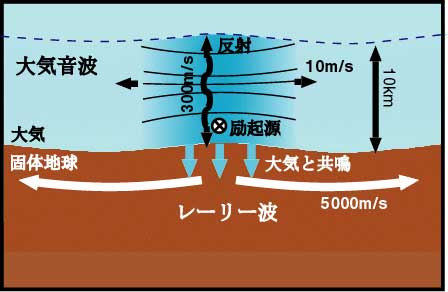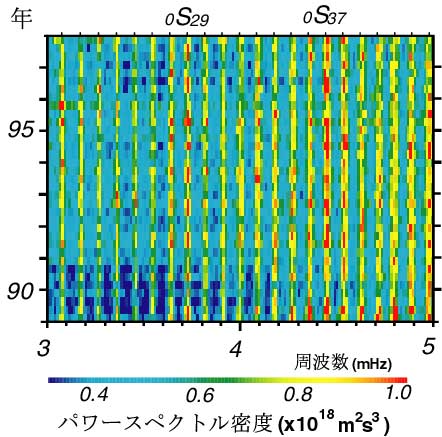
Earth's background free oscillations have now been firmly established.
They comprise the fundamental
spheroidal modes with amplitudes on the order of 0.5 ngal. The cumulative
effects of many small
earthquakes are too small to explain the modal amplitudes. The statistical
examination of the excited
normal modes suggests that atmospheric disturbance may be an excitation
source. Here we report (1)
evidence of the annual variation of this phenomenon and (2) evidence
of acoustic resonance of these
seismic free oscillations.
Preferential excitation of the seismic modes that can couple atmospheric
acoustic modes has been
reported. For example, Rayleigh waves with particular periods of about
225 and 270 s were observed to
be associated with the volcanic eruption of Mount Pinatubo. Thus, some
excess excitations at these
frequencies are expected if atmospheric phenomena excite the oscillations
(Figure 1). From the
analysis of seismic records we found the evidence for greater amplitudes
of the two acoustic coupled
modes than the other modes (Figure 2). The resonant amplitudes suggest
that the excitation source is
at or just above the Earth's surface.
A dimensional analysis by Kobayashi and Nishida [1998] indicates that
atmospheric disturbance can
generate Earth's free oscillations at a ngal-level with a possible
annual variation of intensities on the
order of 10% (Figure 2).
The phenomenon can be understood only if the two systems of the solid
Earth and atmosphere are
viewed as a coupled system.


[1] Kanamori, H. and J.Mori, Geophys. Res. Lett., 19, 721, 1992.
[2] Kobayashi, N. and K. Nishida, Nature, 395, 357-360, 1998.
[3] Nishida, K. and N. Kobayashi, J. Geophys. Res., 104, 28741, 1999.
[4] Nishida, N., Kobayashi and Y. Fukao, Science, 287, 2244-2246, 2000.